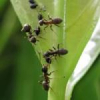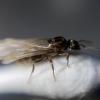First off, I want to note that I realize this experiment might seem cruel to some. I understand this, as I realize the consequences will undoubtedly be the death of quite a few queens. However, it should be remembered that this - at least to my understanding - is not something unheard of in nature, which is why I'm choosing to test it out.
One queen was caught the 24th of July, at around noon.
The remaining 7 queens were caught the 1st of August, at midday.
My garden was swarmed with hundreds of queens, all trying to find holes, cracks and crevices to hide in.
I had recently read that L. niger queens will sometimes found the colony with more than one queen - at least until the first nanitics arrive. I decided to see if this was true, and also if it would allow for a stronger founding colony.
All queens were relocated to the standard test tube setup after coming home. I currently have one set up with the first queen I caught, one with two queens and one with five.
The first queen is doing well, as expected. She's laid a small pile of eggs and is now just waiting. My sight isn't very good, but I reckon the clutch is around 1.5-2 mm in diameter at the current time (7th of August). Nothing out of the ordinary.
The two queens are doing surprisingly well. The first few days, one seemed to have settled in, while the other was having difficulties doing so. She seemed to be almost hostile towards the other queen, and I was relatively sure it wouldn't work out. She would climb the other queen, (gently) bite her and just generally show what seemed like aggression. However, the last couple of days, both have settled down. Not only that, but their clutch of eggs has grown much bigger than that of the first queen (closer to 5-5.5 mm in diameter). I am wondering if the first few days were just a display of dominance, perhaps for when it has to be decided who is the strongest.
The last test tube, consisting of five queens, is doing alright. They took longer to settle down and they also seem more prone to panicking from disturbances, such as vibrations and light. Their egg clutch is larger than that of the two queens, although not by a lot. Perhaps due to the longer settling time.
It should be noted that the two colonies with multiple queens were given test tubes with a diameter of 1.5 cm, while the sole queen was given a test tube with a diameter of 1.1-1.2 cm.
That's all I have for now. I'm looking forward to how this will pan out. I am slightly worried that the five queens might just kill each other, leaving no survivors. Other than that, it seems to be working for now!





















